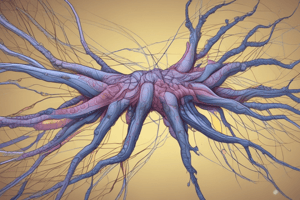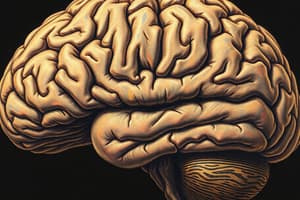Podcast
Questions and Answers
What are the three types of nervous systems?
What are the three types of nervous systems?
- Central
- Peripheral
- Enteric
- All of the above (correct)
The ___________ nervous system involves voluntary actions.
The ___________ nervous system involves voluntary actions.
somatic
What are the main components of the central nervous system (CNS)?
What are the main components of the central nervous system (CNS)?
Brain and spinal cord
Which type of glial cell forms the myelin sheath?
Which type of glial cell forms the myelin sheath?
Grey matter is composed of myelinated axons.
Grey matter is composed of myelinated axons.
What is the function of the blood-brain barrier (BBB)?
What is the function of the blood-brain barrier (BBB)?
Cerebrospinal fluid (CSF) provides __________ to the brain.
Cerebrospinal fluid (CSF) provides __________ to the brain.
What structures are formed by the choroid plexuses?
What structures are formed by the choroid plexuses?
Which part of the nervous system is involved in involuntary actions?
Which part of the nervous system is involved in involuntary actions?
The brain consists of __________ interconnected ventricles.
The brain consists of __________ interconnected ventricles.
What does cerebrospinal fluid help protect the brain from?
What does cerebrospinal fluid help protect the brain from?
Study Notes
Organization of the Nervous System
- Three nervous systems: central, peripheral, and enteric.
- Central nervous system (CNS): brain and spinal cord.
- Peripheral nervous system (PNS): afferent (sensory) and efferent (motor) pathways.
- Somatic nervous system (SNS): voluntary actions.
- Autonomic nervous system (ANS): sympathetic (fight-or-flight) and parasympathetic (rest-and-digest) involuntary actions.
- Enteric nervous system (ENS): controls digestion and is controlled by the ANS.
Cells in the CNS
- Neurons are the functional units of the nervous system.
- Glial cells (90% of CNS cells) provide structural and metabolic support for neurons.
- Astrocytes: star-shaped cells that create the blood-brain barrier.
- Provide structural framework for the CNS.
- Transport nutrients from blood to neurons.
- Degrade neurotransmitters.
- Remove toxic byproducts from the brain.
- Oligodendrocytes: form the myelin sheath around axons.
- Microglia: immune cells of the CNS.
- Inactive - release of growth factor
- Active – engulf foreign invaders and cellular debris.
- Involved in neurodegenerative diseases.
- Ependymal cells line the ventricles of the brain and central canal of the spinal cord and produce cerebrospinal fluid (CSF).
Gray and White Matter
- Gray matter: densely packed neuronal cell bodies and unmyelinated axons.
- White matter: myelinated axons.
- In the brain: gray matter is on the outside and white matter on the inside.
- In the spinal cord: gray matter is on the inside and white matter on the outside.
- Myelin sheath speeds up nerve impulse transmission.
Protection of the CNS
- Bony structure: cranium (skull) and vertebral column (spine).
- Meninges: protective membranes surrounding the CNS.
- Dura mater: outermost, tough layer.
- Arachnoid mater: middle, web-like layer.
- Pia mater: innermost, delicate layer attached to the brain and spinal cord.
- Cerebrospinal fluid (CSF): cushions and protects the CNS, filling the ventricles of the brain and central canal of the spinal cord.
- Blood-brain barrier (BBB): regulates the passage of substances between the blood and the CNS.
Blood-Brain Barrier
- Formed by tight junctions between the endothelial cells of brain capillaries.
- Astrocytes contribute to the BBB by surrounding capillaries.
- Material exchange: blood → endothelial cells → astrocyte → neuron.
- Lipid-soluble substances (e.g., oxygen, carbon dioxide, alcohol, steroids) can diffuse freely through the BBB.
- The pituitary gland and hypothalamus are not fully protected by the BBB.
- Functions of the BBB: protects the brain from harmful substances in the blood and limits the penetration of many drugs.
The Brain is Hollow
- The CNS begins as a hollow tube (neural tube) during embryonic development.
- The neural tube remains hollow as the brain regions develop.
- The brain contains four interconnected ventricles: left lateral, right lateral, third, and fourth ventricles.
- The ventricles continue as the central canal in the spinal cord.
- Ventricles are filled with cerebrospinal fluid (CSF).
Cerebrospinal Fluid (CSF)
- Approximately 150 ml of CSF circulating in the CNS.
- Has a similar density to the brain, allowing the brain to "float" in a fluid environment.
- Formed by the choroid plexuses, specialized structures in the walls of the ventricles composed of ependymal cells.
- Flows through the ventricles and spinal cord.
- Reabsorbed by the subarachnoid space.
- Protects the brain from impact during sudden movements.
Studying That Suits You
Use AI to generate personalized quizzes and flashcards to suit your learning preferences.
Related Documents
Description
Explore the intricate organization of the nervous system, including the central, peripheral, and enteric systems. Learn about the different cells that make up the central nervous system, such as neurons and glial cells, along with their functions. This quiz covers essential concepts of nervous system structure and function.




